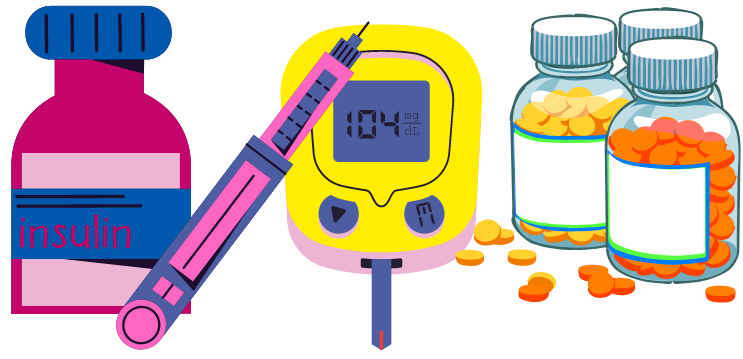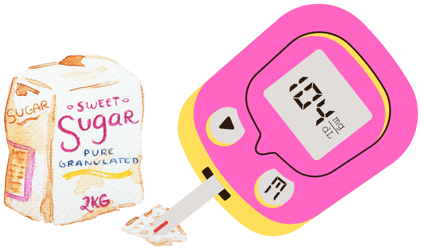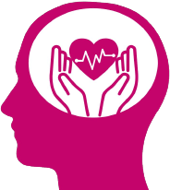
Locate services & resources in your community
Find diabetes services near you using this interactive map.
If you would like to provide feedback please complete this form:
Learn More About Diabetes:

What is Type 1 Diabetes?
Type 1 diabetes occurs when the body doesn't produce enough insulin or when there is a progressive loss of insulin production because the insulin producing cells are damaged by the immune system.
Type 1 diabetes affects fewer than 10% of all patients with diabetes mellitus and is most commonly diagnosed in children and young adults. Type 1 diabetes is most effectively treated with daily insulin injections.
Symptoms:
- Unexpected Weight Loss
- Frequent Urination
- Frequently Feeling Thirsty
- Frequently Feeling Hungry
- Fatigue & Loss of Energy
- Blurred Vision
Risk Factors:
- Family History of Type 1 Diabetes
- Pancreatitis
- Cystic Fibrosis
Acute Complications:
- Ketoacidosis (DKA)
Chronic Complications:
- Kidney Damage
- Heart Disease
- Blindness
- Frequent Infections
- High Blood Pressure
- Nerve Damage
.......................................................................................................................................................................................................................
Type 2 Diabetes

What is Type 2 Diabetes?
When you have type 2 diabetes, your body can't produce enough insulin that is required to control blood sugar levels because of resistance to its affect.
Type 2 diabetes commonly occurs in those who are overweight and obese, beginning in the middle age. Type 2 diabetes can also occur in youth, where obesity is a major risk factor. Type 2 diabetes may present without symptoms initially, making it "silent".
Over 90% of individuals affected by diabetes suffer from type 2 diabetes.
Symptoms:
Type 2 diabetes may be asymptomatic and silent, if not, these are some symptoms:
- Frequent Urination
- Frequently Feeling Thirsty
- Skin Infections
- Urinary Tract Infections
- Fatigue
Risk Factors:
- Family History of Diabetes
- History of Prediabetes
- Long Standing Overweight/Obesity
- Ageing
Complications:
- Coronary Heart Disease
- Stroke
- High Blood Pressure
- Acute & Chronic
- Urinary Tract Infection
- Nerve Damage
- Peripheral Vascular Disease
- Amputation
.......................................................................................................................................................................................................................
Gestational Diabetes

What is Gestational Diabetes?
Gestational diabetes occurs during pregnancy in women who do not have diabetes, when hormonal changes affect the body's response to insulin. It typically occurs in women who are overweight or obese and usually goes away after giving birth. However, about 50% of women with gestational diabetes go on to develop type 2 diabetes.
Gestational diabetes is usually tested for between 24 and 28 weeks of pregnancy, although your doctor may recommend earlier testing depending on risk factors.
Symptoms:
Gestational diabetes does not usually show any symptoms. However, some women can develop the following symptoms:
-
- Frequently Feeling Thirsty
- Blurred Vision
- Frequent Urination
Risk Factors:
- Family History of Diabetes (including prediabetes & gestational diabetes)
Complications
- Preterm Birth/Early Birth
- High Blood Pressure
- Increased Risk of Obesity for Baby
- Increased Risk of Baby Developing Diabetes
.......................................................................................................................................................................................................................
Prediabetes

What is Prediabetes?
Prediabetes is when the blood glucose level is higher than normal, but not high enough to be classified as diabetes. Prediabetes puts you at a risk for developing type 2 diabetes. However, by making lifestyle changes such as having a healthy diet, regular physical activity, and weight loss, you can reduce these risks.
There are no complications associated with prediabetes. The major risk of prediabetes is progression to type 2 diabetes and greater the risks linked to that condition.
Symptoms:
Prediabetes may not show any symptoms. If the prediabetes were to progress to type 2 diabetes, then there may be more noticeable symptoms. However, some people with prediabetes may experience:
- Frequent Urination
- Frequently Feeling Thirsty
- Frequently Feeling Hungry
- Feeling Weak & Tired
- Blurred Vision
Risk Factors:
- Family History
- Chronic Overweight or Obesity
Complications:
- Developing Type 2 Diabetes (No complication with prediabetes, unless prediabetes progresses to type 2 diabetes.)
.......................................................................................................................................................................................................................

Healthy Diet
Having a nutritious diet is essential in managing diabetes. Avoiding unhealthy snacks will help you manage your blood glucose levels and help in achieving proper blood lipid (fat) levels.

Regular Physical Activity
Physical activity can make your body more sensitive to insulin, helping reduce blood glucose levels. It is also a great way to maintain your mental health and stay fit.

Managing Your Weight
Being overweight can put you at a greater risk for developing complications. Fat building up around your pancreas can lead to a greater insulin resistance, so it is important to manage your weight.

Taking Insulin & Medications
Insulin helps to regulate blood glucose levels. Following your physician's directions when it comes to medication and insulin can help you effectively and properly manage your blood glucose levels.

Monitoring Blood Glucose Levels
Monitoring your blood glucose levels can show you different patterns such as the impact of certain foods on glucose levels. This can be useful when coming up with a management plan like a diet.

Managing Your Mental Health
Diabetes is a chronic disease which can impact your mental health. Managing your mental health is important; if you are struggling, reach out to someone you trust or your primary care provider.
Diabetes Canada – Type 2 Diabetes: The Basics

Information about type 2 diabetes. Mentions risk factors, complications, ways to reduce your chance of developing complications, and much more.
Source:
Diabetes Canada
Community Resources for People Living with Diabetes

Various resources for those living with diabetes. These resources include dental, foot care, and housing. Income support and financial resources are also listed.
Source:
University Health Network
Get Support For Diabetes Equipment and Supplies

Government of Ontario’s website for diabetes supplies and equipment as well as different education programs available for adults and children.
Source:
Government of Ontario

Frequently Asked Questions
- What is Diabetes Wayfinder doing?
Diabetes Wayfinder is a digital tool that helps those living with diabetes, their family members, and their caregivers access diabetes services such as treatment centers, clinics, and education programs in their community. - I am looking for a specific service, how can I find it?
You can customise your search by selecting the filters that apply to you. This will only show services that fit your criteria such as the service’s language or whether they are accepting new patients. - How can I contact the service?
Contact information such as address and phone number will be available when you click on the service. If the service has an online appointment booking page, a link to the page will also be displayed. You can contact the service by phone number or by booking an appointment. - Is the information accurate and up-to-date?
Yes, our information gets updated frequently to ensure all the information is up-to-date and accurate. - I want to share my experience with you, can I share feedback?
Of course! We would love to hear back from you and get your opinion on how we can improve this service. To share feedback, please send an email to team@diabeteswayfinder.ca.
-1.png?width=1510&height=964&name=image%20(36)-1.png)